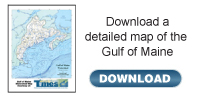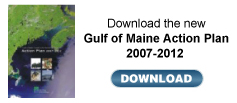Boston Harbor insect census:
Looking to tiny creatures to tell the big story on the environment
By Lori Valigra
 THEY STING, CRAWL ON PICNIC FOOD and buzz around your ears when you hike. They also pollinate flowers, serve as food for other species and act as predators. Lowly insects may find themselves elevated to an even larger role in the future: as indicator species for changes in the environment. THEY STING, CRAWL ON PICNIC FOOD and buzz around your ears when you hike. They also pollinate flowers, serve as food for other species and act as predators. Lowly insects may find themselves elevated to an even larger role in the future: as indicator species for changes in the environment.
Scientists at Harvard University and elsewhere are studying a relatively self-contained area in Massachusetts to create an All Taxa Biodiversity Inventory, or ATBI, of insects within the Boston Harbor Islands national recreation area. The researchers are developing a database at Harvard with high-resolution images and descriptions of insects—they already have more than 900 entries—present in the recreation area. The hope is that one day the insects can inform them of extinctions of plant or animal species, invasions of non-native species and even the impacts of changes in climate. But first, they have to find and identify which insects are present.
“More than 90 percent of life on earth is insects, and 98 percent of life is invertebrates,” said Mary Raczko, partnership liaison with the Boston Harbor Islands national recreation area, whose park rangers and other staff are collaborating with Harvard’s Museum of Comparative Zoology to conduct the ATBI. The five-year ATBI, now in its third year, started with insects, but the Boston Harbor Islands researchers aim eventually to create an inventory of a broad range of plants and animals on the 34 islands and peninsulas comprising the national recreation area and use biodiversity data to help manage its resources.
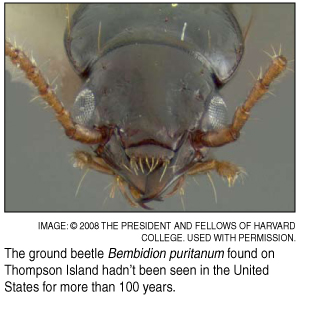 Ultimately, similar ATBI studies conducted across the United States and the rest of the world could be used for broad comparisons, such as looking at the impact of weather and climate changes on species like insects. But that may be decades away. For now, it’s not possible to talk about the impacts of global warming until researchers identify what species exist in a certain location, and then compare them over time, said Brian Farrell, principal investigator at Harvard and a key participant in the Boston Harbor Islands project. Ultimately, similar ATBI studies conducted across the United States and the rest of the world could be used for broad comparisons, such as looking at the impact of weather and climate changes on species like insects. But that may be decades away. For now, it’s not possible to talk about the impacts of global warming until researchers identify what species exist in a certain location, and then compare them over time, said Brian Farrell, principal investigator at Harvard and a key participant in the Boston Harbor Islands project.
“We’re establishing a baseline snapshot of what is on the islands today,” Farrell said. “There’s no single reference source to find out what some of these species are. These kinds of databases [ATBI], if they’re replicated across the country, will be nerve centers to identify species locally.”
The Boston Harbor Islands/Harvard ATBI is modeled to a large degree on similar work at the Great Smoky Mountains National Park in Tennessee. Both of those, and others including the Nantucket Biodiversity Initiative and Acadia National Park in Maine, are members of the ATBI Alliance, a group of U.S. national and state parks and preserves looking to identify living organisms within their boundaries.
“The Boston Harbor Islands are small enough and conspicuous enough to finish a project like this within a reasonable amount of time and do comparisons along the way,” said Farrell.
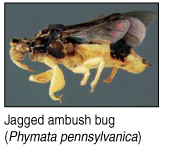 Get your bugs straight Get your bugs straight
The word “bug” is a vernacular term that generally means some insect. But to entomologists “bug” is a scientific term referring to a particular type of insect with a sucking mouth part that is a member of the order Hemiptera. Such “true” bugs include aphids and cicadas. |
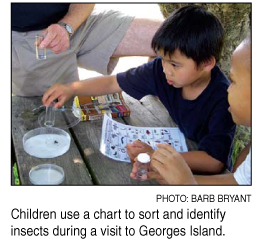 Another unique aspect of the Boston Harbor Islands/Harvard ATBI is the high-quality images of the insects in the database. It is difficult to see tiny insects under a traditional white light microscope, Farrell said. So his group adopted commercial computer and software technology used to image cells in biology. That technology allows pictures of an insect to be taken at 10 to 30 different focal planes, or angles to the insect, and then stitched together into one very high-resolution, focused image. Farrell claimed that kind of detailed, fully focused image of an insect is unprecedented, and it is the heart of the ATBI project. Another unique aspect of the Boston Harbor Islands/Harvard ATBI is the high-quality images of the insects in the database. It is difficult to see tiny insects under a traditional white light microscope, Farrell said. So his group adopted commercial computer and software technology used to image cells in biology. That technology allows pictures of an insect to be taken at 10 to 30 different focal planes, or angles to the insect, and then stitched together into one very high-resolution, focused image. Farrell claimed that kind of detailed, fully focused image of an insect is unprecedented, and it is the heart of the ATBI project.
When more parks conduct ATBI projects and there are regional databases all over the country, it will be easier to start talking more knowledgeably about large issues like the impact of global warming. “It will be great data to compare over time and see how distributions of insects change with time in a region. So I think it will be very valuable long term, over the next 10 to 100 years,” added Jessica Rykken, a postdoctoral fellow at Harvard’s Museum of Comparative Zoology who is coordinating the ATBI with the Boston Harbor Islands.
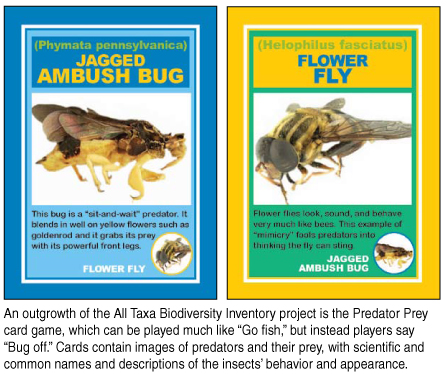
Shorter term, Rykken said the insect data can help answer what happens when vegetation changes on the islands. The Boston Harbor Islands have a lot of non-native plant species, and more and more the invasive species are being removed and replaced with native species. “So by looking at species of bees and other pollinators, we can do before and after studies of what happens to them when the plants are changed,” she said.
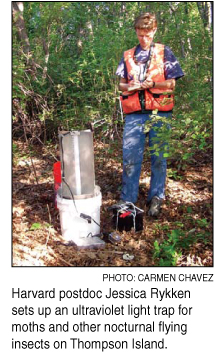 Although Rykken and Farrell say one might not expect to find too many new species on such established islands, there is quite a bit of biodiversity. One ground beetle (Bembidion puritanum) they found on Thompson Island hadn’t been seen in the United States for more than 100 years. Another tiny wasp was found on Thompson Island as well, and the only other species found in that genus is in the southwestern United States, so the wasp on Thompson might be a new species, Farrell said. In addition, Rykken and her helpers found five species of sow (potato) bugs throughout the islands, but on Spectacle Island they found three additional species that they hadn’t seen anywhere else. “My hypothesis is that they came in with the soil from the Big Dig,” she said, referring to Boston’s large Central Artery project. Although Rykken and Farrell say one might not expect to find too many new species on such established islands, there is quite a bit of biodiversity. One ground beetle (Bembidion puritanum) they found on Thompson Island hadn’t been seen in the United States for more than 100 years. Another tiny wasp was found on Thompson Island as well, and the only other species found in that genus is in the southwestern United States, so the wasp on Thompson might be a new species, Farrell said. In addition, Rykken and her helpers found five species of sow (potato) bugs throughout the islands, but on Spectacle Island they found three additional species that they hadn’t seen anywhere else. “My hypothesis is that they came in with the soil from the Big Dig,” she said, referring to Boston’s large Central Artery project.
“You can make new discoveries in Boston’s back yard, because this level of discovery hasn’t been done in many places,” said Farrell.
A large part of the insect ATBI is education: the Web site, posters, maps and activities for citizen and professional scientists. There’s even a card game that is being sold at the Harvard Museum of Natural History, of which the Museum of Comparative Zoology is a part, and at various Boston Harbor islands. Players have to match insect predators pictured on the cards with their insect prey on other cards. Both the museum and Spectacle Island also are planning ATBI exhibits this summer.
A recent trend has been the “bioblitz,” typically a 24-hour event where scientists and citizens are invited to catch as many insects as possible. So far, several “beetle blitzes” have revealed 80 types of ground beetles on the islands. Farrell said the islands have greater-than-expected biodiversity, including 40 ant species and 80 bee species.
The Boston Harbor Islands is planning an “intertidal bioblitz” on August 18 (see the Boston Harbor Islands Web site in the “Resources” section). There are at least 12-16 species of crabs, snails, burrowing worms and insects, said Raczko of the Boston Harbor Islands.
“Bioblitzes are spreading worldwide and nationwide. They’re analogous to the Christmas bird count,” added Farrell. “It’s a way for everyday people to do citizen science.”
Lori Valigra is editor of the Gulf of Maine Times. She also writes about science, technology, business and other topics from Cambridge, Massachusetts.
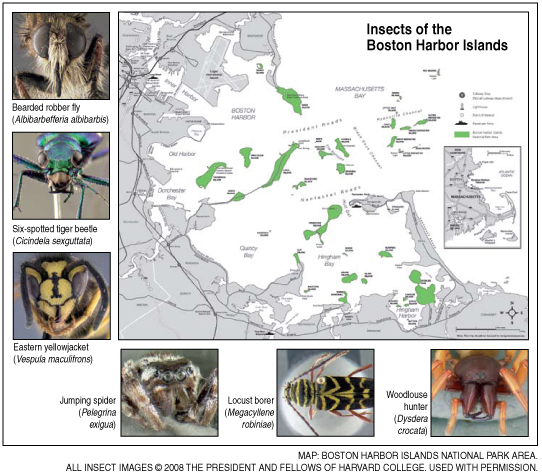
[enlarge map]
[ back to top ]
|






